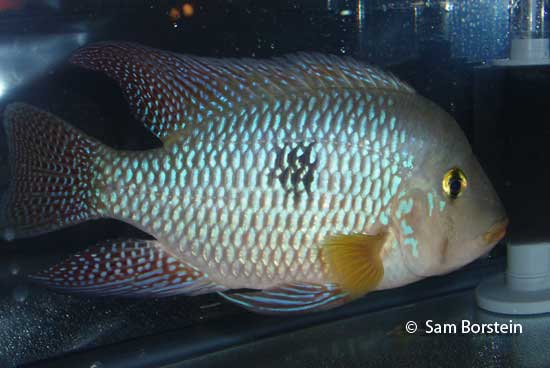'Geophagus' brasiliensis
(Quoy & Gaimard, 1824)
Pearlscale Eartheater

Above: A male Pearlscale Eartheater. Photo by Sam Borstein.
Etymology:
Genus- Geos= Earth (Greek), Phagein= Eat (Greek)
Species- brasiliensis= Named after Brazil.
Intro:
'Geophagus' brasiliensis is a eartheater from Brazil. The Geophagines are split up into complexes. The 'Geophagus' crassilabrus and 'Geophagus' brasiliensis complexes are awaiting desriptions for new genera.'Geophagus' brasiliensis is well known to hobbyists and is an easy fish to obtain and keep, making it very popular. This fish is stiunningly colorful and is unproblematic to keep even though it is rather robust.
- Geophagus- Contains species like the Geophagus altifrons, and Geophagus proximus
- 'Geophagus' crassilabrus complex- Thes are all the immediate mouthbrooding Geophagus like 'Geophagus' steindachneri.
- 'Geophagus' brasiliensis complex- All the Pearlscale Eartheaters like 'Geophagus' brasiliensis and 'Geophagus' iporangensis.
You will commonly see 'Geophagus' written in quotes like this because it doesn't represent the other Geophagus species. The true Geophagus species are those of the Geophagus altifrons, Geophagus brokopondo, and Geophagus dicrozoster types. The Red Hump and Brasiliensis group of 'Geophagus' will eventually be assigned to their own genus (Weidner, 2000).
Distribution:
'Geophagus' brasiliensis is found in coastal rivers in the East and Southeast of Brazil, giving it the name brasiliensis. A similar fish also occurs in Uruguay, but this may be a new species.
Size, Maturity, and Sexual Dimorphism:
Size: Males- 12 inches, Females-8 inches
Maturity: 2.5 inches
Sexual Dimorphism: Males are larger than females and may develop a nuchal hump. Males also have more spangles on their flanks and longer fins.
Care:
'Geophagus' brasiliensis is easy to care for. This fish will accept multiple water types and pH ranges. I know people who have kept this fish in a pH of 6, and others who have kept this fish at a pH of 8 or a little higher.
'Geophagus' brasiliensis is also not very aggressive. You can keep this fish with almost anything. I had a species tank for mine because I was concentrating on spawning them, but they will do fine with Africans, and other Central and South American cichlids. When at 4-5 inches you can keep 4 in a 40 gallon species tank. If you do this be sure to do 50-75% water changes weekly because this is a messy fish.
Like all Geophagus, this is a sand sifting species and does best when kept on a sand substrate.
Diet:
'Geophagus' brasiliensis is a omnivore, searching for edibles by sifting through the sand. In an aquarium this fish will accept almost any kind of prepared food. I like spectrum and tetra cichlid sticks as they put weight on the fish and keep them in good condition.
Breeding:
'Geophagus' brasiliensis is easy to breed... sort of. Everyone I know said they were very easy to breed, and had no problems, so here is my story.
I got 5 fish from a GCCA swap meet and put them in a 20 gallon. The fish were doing fine, and growing fast. It took them a while to pair off. I bought some smaller ones at another swap I thought might be females because all of mine were rather large. I placed some of the larger ones into a separate tank leaving the largest one thinking he was my dominant male. They didn’t breed, so I put the fish back, where one of the large ones I moved to a separate tank killed off the other two large ones. It wound up that I got two-pairs from 4 fish. This fish finally spawned and I was so excited, but the damn fish spawned on the glass. I let them try to raise the eggs, like I do with every fish when they first spawn, and they ate them. I had rocks, flower pots, and slate in the tank, and sure enough they bred again, on the damn glass. They did this six more times and I was getting frustrated because they kept on eating their spawn.
Finally, they bred in a flower pot. I promptly took the flower pot and put it in the 5, with an air stone, and some anti-fungal products. Half the eggs hatched and I raised they fry with no problem. The fry do great on baby brine shrimp and grow rather quickly.
Conclusion:
'Geophagus' brasiliensis is a great fish to keep, large ones are beautiful. This is a nice peaceful fish. If you are just getting into cichlids, or the eartheaters, I recommend this fish. This fish is usually available at pet shops, and if it isn’t there, there is probably someone in your club with them.
References:
- Weidner, T., (2000) South American Eartheaters. Cichlid Press, El Paso.
